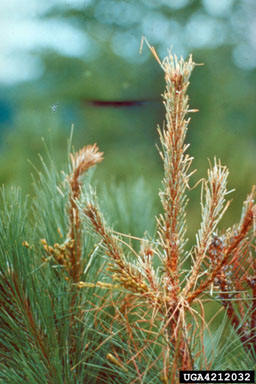

Host: Slash, longleaf, loblolly, Virginia and occasionally other pines.
Importance: The redheaded pine sawfly, (Neodiprion lecontei), blackheaded pine sawfly, (Neodiprion excitans) and loblolly pine sawfly (Neodiprion taedae lineari) attack most species of pines in Alabama, although they have preferred hosts. Usually they attack single or small groups of trees; however, if conditions are favorable, they may infest and defoliate thousands of acres. Repeated attacks for two or more years may cause mortality, but the main loss is tree growth.
Identification: Adults are small heavy-bodied four-winged "flies” seldom observed. Larvae are yellowish-white or light green. When mature, redheaded pine sawfly larvae are about one-inch long, yellowish-green with six rows of conspicuous black spots and a red head. The blackheaded pine sawfly larvae are about one-inch long, light greenish in color with four distinct stripes along the top and a shiny black head. Loblolly pine sawfly larvae are about one-inch long, black on top with light greenish color underneath and a red head.
Signs of Attack: Sawfly attacks usually go unnoticed until needles are almost completely consumed, or until larvae are almost fully developed and large numbers are clustered in groups. Reddish straw-like remains of needles indicate feeding by young larvae. Large amounts of boring dust beneath the tree, and cocoons in the humus, soil or on the needles clearly indicate a sawfly infestation.
Life Cycle: In spring, females lay eggs in needles of host pines. Individual slits are cut for each egg with a saw-like ovipositor and from 10 to 30 eggs are laid in eaneedle. Larvae feed on the needles and mature in 3 to 6 weeks. They drop or crawl to the ground andspin silken cocoons in the humus or soil. Cocooning also occurs on needles, limbs and trunk of the tree, particularly if the ground is flooded. Usually not all of the larvae pupate immediately, but may remain in the cocoon for one to three years. As many as three or four generations may develop eyear with large population buildups and severe defoliation usually occurring in late summer to late fall.
Control: Chemical controls are not recommended or necessary in forests since heavy defoliation and large outbreaks occur only sporadically. Even though hundreds of acres of pines may be defoliated one year, very few larvae or defoliated trees are observed the next because of natural controls, e.g., weather, predators, parasites, and disease organisms. If populations are not reduced by the second year, insecticides may be necessary. For ornamental pines, hand-picking or spraying may easily control the insects. Large trees or areas may require special spray equipment.
Photo credit: Minnesota Department of Natural Resources Archives, Minnesota Department of Natural Resources; Gerald J. Lenhard, Louisiana State University, ForestryImages.Org
Additional Resources